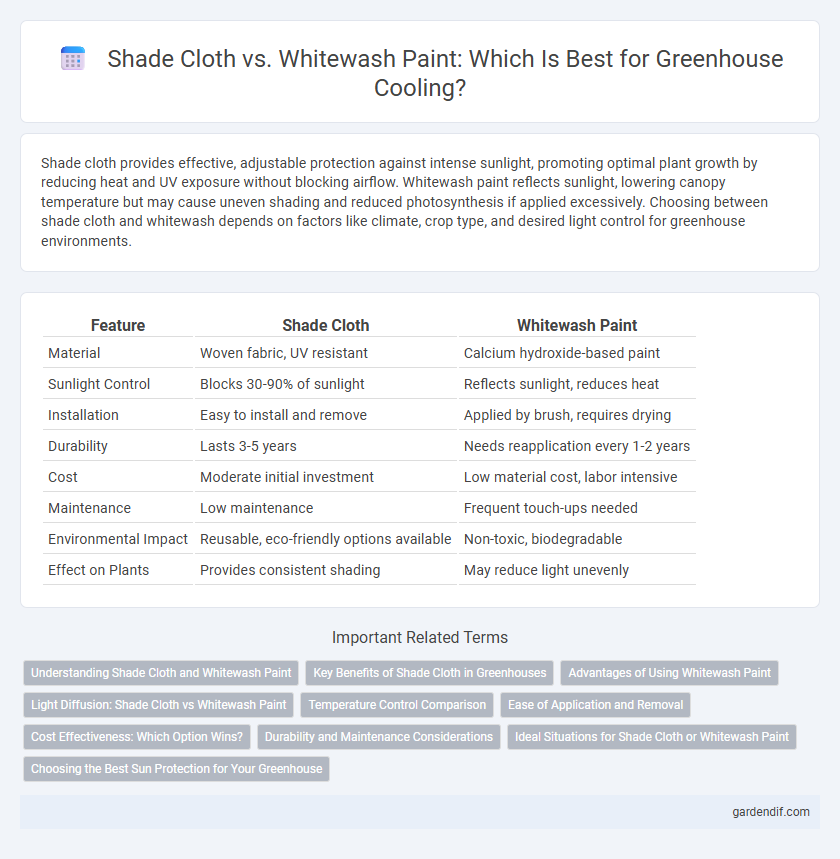
Shade cloth vs Whitewash paint Illustration
Shade cloth provides effective, adjustable protection against intense sunlight, promoting optimal plant growth by reducing heat and UV exposure without blocking airflow. Whitewash paint reflects sunlight, lowering canopy temperature but may cause uneven shading and reduced photosynthesis if applied excessively. Choosing between shade cloth and whitewash depends on factors like climate, crop type, and desired light control for greenhouse environments.
Table of Comparison
| Feature | Shade Cloth | Whitewash Paint |
|---|---|---|
| Material | Woven fabric, UV resistant | Calcium hydroxide-based paint |
| Sunlight Control | Blocks 30-90% of sunlight | Reflects sunlight, reduces heat |
| Installation | Easy to install and remove | Applied by brush, requires drying |
| Durability | Lasts 3-5 years | Needs reapplication every 1-2 years |
| Cost | Moderate initial investment | Low material cost, labor intensive |
| Maintenance | Low maintenance | Frequent touch-ups needed |
| Environmental Impact | Reusable, eco-friendly options available | Non-toxic, biodegradable |
| Effect on Plants | Provides consistent shading | May reduce light unevenly |
Understanding Shade Cloth and Whitewash Paint
Shade cloth is a woven or knitted fabric designed to reduce sunlight intensity and regulate temperature within greenhouses, offering protection from UV rays while maintaining airflow. Whitewash paint, typically made from lime and water, reflects sunlight by coating greenhouse surfaces, helping to lower internal temperatures and prevent overheating. Understanding these materials involves assessing their effectiveness in light diffusion, durability, and impact on plant growth conditions.
Key Benefits of Shade Cloth in Greenhouses
Shade cloth in greenhouses offers superior temperature regulation by blocking excessive sunlight and reducing heat buildup, which promotes optimal plant growth. It provides better ventilation compared to whitewash paint, preventing humidity accumulation and reducing the risk of fungal diseases. Durable and reusable, shade cloth ensures consistent light diffusion and energy efficiency, enhancing crop yield and quality throughout various growing seasons.
Advantages of Using Whitewash Paint
Whitewash paint provides superior light diffusion in greenhouses, promoting uniform plant growth and reducing shadowing. Its reflective properties help regulate internal temperature by minimizing heat absorption, thus enhancing energy efficiency. Whitewash paint is also cost-effective, easy to apply, and environmentally friendly compared to synthetic shade cloth materials.
Light Diffusion: Shade Cloth vs Whitewash Paint
Shade cloth provides controlled light diffusion by filtering sunlight through its woven fibers, reducing intensity and preventing hotspots in greenhouse environments. Whitewash paint offers uniform light scattering by creating a reflective, opaque coating on greenhouse glass, enhancing diffused light distribution evenly across plants. Optimal light diffusion improves photosynthesis efficiency and reduces plant stress, making shade cloth advantageous for adjustable shading while whitewash paint delivers consistent, long-lasting light diffusion.
Temperature Control Comparison
Shade cloth provides superior temperature regulation in greenhouses by effectively reducing solar radiation and allowing better airflow, which prevents overheating without significantly limiting light penetration. Whitewash paint reflects sunlight, lowering surface temperatures but often reduces light intensity inside the greenhouse, potentially affecting plant growth. For optimal temperature control, shade cloth is preferred as it balances heat reduction with adequate light transmission, enhancing plant health and productivity.
Ease of Application and Removal
Shade cloth offers straightforward installation and removal, typically secured with clips or ties that allow for quick adjustment or replacement. Whitewash paint requires careful application with brushes or sprayers and demands more time to dry, while its removal involves labor-intensive washing or repainting. The reusable nature of shade cloth provides significant convenience over the more permanent and maintenance-heavy whitewash solution in greenhouse shading.
Cost Effectiveness: Which Option Wins?
Shade cloth offers superior cost effectiveness compared to whitewash paint by providing durable, reusable protection against excessive sunlight without frequent reapplication. Initial investment in quality shade cloth may be higher, but it significantly reduces long-term maintenance and replacement expenses. Whitewash paint is cheaper upfront but requires regular repainting, increasing labor and material costs over time.
Durability and Maintenance Considerations
Shade cloth offers superior durability compared to whitewash paint, lasting up to 5-10 years under harsh sunlight without frequent replacement. Maintenance for shade cloth is minimal, requiring occasional cleaning to remove dust and debris, while whitewash paint demands regular reapplication every 1-2 years due to fading and peeling caused by weather exposure. The UV resistance and tear strength of high-quality shade cloth reduce long-term upkeep costs and enhance overall greenhouse protection.
Ideal Situations for Shade Cloth or Whitewash Paint
Shade cloth is ideal for greenhouses in regions with intense sunlight, as it effectively reduces light intensity while allowing air circulation, preventing excessive heat buildup and protecting plants from sunburn. Whitewash paint suits greenhouses in cooler climates where diffusing sunlight and reflecting heat is needed to maintain moderate temperatures without restricting airflow. Selecting between shade cloth and whitewash paint depends on the greenhouse's specific climate, crop sensitivity to light, and ventilation requirements.
Choosing the Best Sun Protection for Your Greenhouse
Shade cloth offers adjustable sun protection for greenhouses, allowing control over light intensity and reducing heat buildup more effectively than whitewash paint. Whitewash paint provides a cost-effective, temporary solution by reflecting sunlight, but it can reduce light quality and requires frequent reapplication. Selecting the best option depends on factors like crop type, climate, and desired light levels to optimize plant growth and energy efficiency.
Shade cloth vs Whitewash paint Infographic

 gardendif.com
gardendif.com